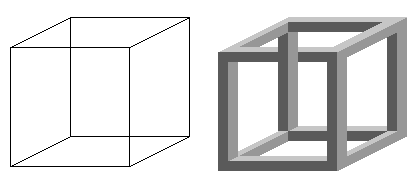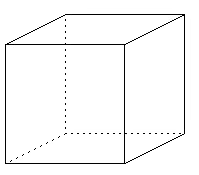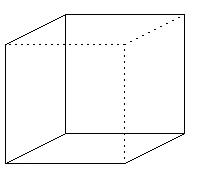Difference between revisions of "Necker cube" - New World Encyclopedia
(Started) |
|||
| Line 1: | Line 1: | ||
| − | {{Claimed}} | + | {{Claimed}}{{Started}} |
[[Category:Politics and social sciences]] | [[Category:Politics and social sciences]] | ||
[[Category:Psychology]] | [[Category:Psychology]] | ||
Revision as of 16:43, 14 September 2007
The Necker cube is an optical illusion first published in 1832 by Swiss crystallographer Louis Albert Necker.
Ambiguity
The Necker cube is an ambiguous line drawing. It is a wire-frame drawing of a cube in isometric perspective, which means that parallel edges of the cube are drawn as parallel lines in the picture. When two lines cross, the picture does not show which is in front and which is behind. This makes the picture ambiguous; it can be interpreted two different ways. When a person stares at the picture, it will often seem to flip back and forth between the two valid interpretations (so-called multistable perception).

The effect is interesting because each part of the picture is ambiguous by itself, yet the human visual system picks an interpretation of each part that makes the whole consistent. The Necker cube is sometimes used to test computer models of the human visual system to see whether they can arrive at consistent interpretations of the image the same way humans do.
Humans do not usually see an inconsistent interpretation of the cube. A cube whose edges cross in an inconsistent way is an example of an impossible object, specifically an impossible cube (compare Penrose triangle).
With the cube on the left, most people see the lower-left face as being in front most of the time. This is possibly because people view objects from above, with the top side visible, far more often than from below, with the bottom visible, so the brain "prefers" the interpretation that the cube is viewed from above.
There is evidence that by focusing on different parts of the figure one can force a more stable perception of the cube. The intersection of the two faces that are parallel to the observer forms a rectangle, and the lines that converge on the square form a "y-junction" at the two diagonally opposite sides. If an observer focuses on the upper "y-junction" the lower left face will appear to be in front. The upper right face will appear to be in front if the eyes focus on the lower junction (Einhauser, et al., 2004).
The Necker cube has shed light on the human visual system. The phenomenon has served as evidence of the human brain being a neural network with two distinct equally possible interchangeable stable states.[1] Sidney Bradford, blind from the age of ten months but regaining his sight following an operation at age 52, did not perceive the ambiguity that normal-sighted observers do.
Epistemology
The Necker cube is used in epistemology (the study of knowledge) and provides a counter-attack against naïve realism. Naïve realism (also known as direct or common-sense realism) states that the way we perceive the world is the way the world actually is. The Necker cube seems to disprove this claim because we see one or the other of two cubes, but really, there is no cube there at all: only a two-dimensional drawing of twelve lines. We see something which is not really there, thus (allegedly) disproving naïve realism. This criticism of naïve realism supports representative realism.
A rotating Necker cube was used to demonstrate that the human visual system can recruit new visual cues that affect the way things look.
Notes
- ↑ David Marr: Vision. 1982.
ReferencesISBN links support NWE through referral fees
External links
- history of the cube and a Java applet
- modelling human perception of the cube
- Explanation of the Necker cube and other gestalt phenomena
- Video demonstration of the Necker Cube
Credits
New World Encyclopedia writers and editors rewrote and completed the Wikipedia article in accordance with New World Encyclopedia standards. This article abides by terms of the Creative Commons CC-by-sa 3.0 License (CC-by-sa), which may be used and disseminated with proper attribution. Credit is due under the terms of this license that can reference both the New World Encyclopedia contributors and the selfless volunteer contributors of the Wikimedia Foundation. To cite this article click here for a list of acceptable citing formats.The history of earlier contributions by wikipedians is accessible to researchers here:
The history of this article since it was imported to New World Encyclopedia:
Note: Some restrictions may apply to use of individual images which are separately licensed.


